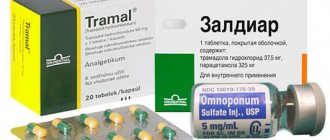Zaldiar tablets p/o bl N10x2 Grünenthal
Concomitant use with opioid agonists/antagonists (buprenorphine, nalbuphine, pentazocine) is not recommended, because the analgesic effect is reduced as a result of a competing effect on the receptors and there is a risk of withdrawal syndrome. When treating the drug together with other drugs that have a depressant effect on the central nervous system (for example, hypnotics or tranquilizers), as well as while taking alcohol, the side effects characteristic of tramadol may be more pronounced. Inducers of microsomal oxidation (including carbamazepine, phenytoin, ethanol, barbiturates, rifampicin, phenylbutazone, tricyclic antidepressants) reduce the analgesic effect and its duration. Naloxone activates breathing, eliminating analgesia. Long-term use of barbiturates reduces the effectiveness of paracetamol. Ethanol contributes to the development of acute pancreatitis. Long-term combined use of paracetamol and other non-steroidal anti-inflammatory drugs increases the risk of developing “analgesic” nephropathy and renal papillary necrosis, and the onset of end-stage renal failure. Simultaneous long-term administration of paracetamol in high doses and salicylates increases the risk of developing kidney and bladder cancer. Diflunisal increases the plasma concentration of paracetamol by 50% - the risk of developing hepatoxicity. Concomitant use with drugs that lower the epileptic threshold, for example, selective serotonin uptake inhibitors, tricyclic antidepressants, antipsychotics, may increase the risk of seizures. Drugs that inhibit CYP3A4, such as ketoconazole and erythromycin, may slow the metabolism of tramadol (N-demethylation) and the active O-demethylated metabolite. Quinidine increases the plasma concentration of tramadol and reduces the concentration of the M1 metabolite due to competitive inhibition of the CYP2D6 isoenzyme. Microsomal oxidation inhibitors (cimetidine) reduce the risk of hepatotoxicity. The rate of absorption of paracetamol may be increased by metoclopramide or domperidone and decreased by cholestyramine. The drug, when taken for a long time, enhances the effect of indirect anticoagulants (warfarin and other coumarins), which increases the risk of bleeding.
Zaldiar
Allergic reactions to the components of the drug: urticaria, itching, Quincke's edema, exanthema, bullous rash.
From the nervous system: dizziness, headache, lethargy, paradoxical stimulation of the central nervous system (nervousness, agitation, anxiety, tremors, muscle spasms, euphoria, emotional lability, hallucinations), drowsiness, sleep disturbance, confusion, impaired motor coordination, convulsions of central origin (with simultaneous prescription of antipsychotic drugs), depression, amnesia, impaired cognitive function, paresthesia, gait instability.
From the digestive system: dry mouth, nausea, vomiting, flatulence, abdominal pain, constipation, diarrhea, difficulty swallowing; increased activity of liver enzymes, usually without the development of jaundice.
From the cardiovascular system: tachycardia, orthostatic hypotension, syncope, collapse.
From the endocrine system: hypoglycemia, up to hypoglycemic coma.
From the urinary system: difficulty urinating, dysuria, urinary retention. With long-term use in doses significantly higher than recommended - nephrotoxicity (interstitial nephritis, papillary necrosis).
From the senses: impaired vision, taste.
From the respiratory system: dyspnea.
From the skin: exudative erythema multiforme (including Stevens-Johnson syndrome), toxic epidermal necrolysis (Lyell's syndrome).
From the hematopoietic organs: sulfhemoglobinemia. With long-term use in doses significantly higher than recommended - aplastic anemia, pancytopenia, agranulocytosis.
Other: sweating, weakness, increased fatigue, menstrual irregularities.
With long-term use - the development of drug dependence (irritability, phobias, nervousness, sleep disturbances, psychomotor activity, tremor, discomfort in the stomach or intestines). If you stop taking it abruptly, you may develop a “withdrawal” syndrome.
Overdose.
Symptoms of tramadol overdose: miosis, vomiting, collapse, coma, convulsions, depression of the respiratory center, apnea.
Symptoms of paracetamol overdose: (acute overdose develops 6-14 hours after taking paracetamol, chronic - after 2-4 days if the dose is exceeded). Symptoms of acute overdose: diarrhea, loss of appetite. Symptoms of chronic overdose: cerebral edema, hypocoagulation, development of disseminated intravascular coagulation syndrome, hypoglycemia, metabolic acidosis, arrhythmia, collapse; rarely - impaired liver function, which develops at lightning speed and can be complicated by renal failure (renal tubular necrosis).
Treatment: gastric lavage and taking enterosorbents (activated carbon, polyphepan), maintaining cardiovascular function, ensuring airway patency.
For respiratory depression (a symptom of tramadol overdose) - naloxone, for convulsions - diazepam. Hemodialysis or hemofiltration are ineffective for tramadol intoxication.
If symptoms of paracetamol overdose appear: administration of SH-group donors and precursors for the synthesis of glutathione - methionine 8-9 hours after the overdose and N-acetylcysteine - 12 hours later. The need for further administration of methionine and intravenous administration of N-acetylcysteine is determined depending on the concentration paracetamol in the blood, as well as the time elapsed after taking it.
Zaldiar®
More than 10% of patients who are prescribed a combination of tramadol and paracetamol experience nausea, dizziness and drowsiness.
The frequency of occurrence of side effects is classified as follows: very often (≥1/10); often (from ≥1/100 to <1/10); uncommon (from ≥1/1000 to <1/100); rare (from ≥1/10000 to <1/1000); very rare (<1/10000); unknown frequency - cannot be estimated from available data.
In each group, adverse reactions are presented in descending order of severity.
Mental disorders:
often - confusion, mood changes, anxiety, nervousness, euphoria, sleep disturbances; infrequently - depression, hallucinations, nightmares; rarely - delirium, drug dependence.
Post-marketing observations
Very rare (<1/10000): abuse.
Nervous system disorders:
very often - dizziness, drowsiness; often - headache, tremor; infrequently - involuntary muscle contractions, paresthesia, amnesia; rarely - ataxia, convulsions, fainting, speech disorders.
Visual disorders:
rarely - blurred vision, miosis, mydriasis.
Hearing and labyrinth disorders:
infrequently - ringing in the ears.
Heart disorders
: uncommon - palpitations, tachycardia, arrhythmia.
Gastrointestinal disorders:
very often - nausea; often - vomiting, constipation, dry mouth, diarrhea, abdominal pain, dyspepsia, flatulence; infrequently - dysphagia, melena.
General disorders and disorders at the injection site:
infrequently - chills, chest pain.
Laboratory and instrumental data:
infrequently - increased transaminase activity, unknown frequency - hypoglycemia.
Renal and urinary tract disorders:
uncommon - albuminuria, urinary disorders (dysuria and urinary retention).
Respiratory, thoracic and mediastinal disorders
: infrequently - shortness of breath.
Disorders of the track and subcutaneous tissues:
often - sweating, itching; uncommon - skin reactions (rash, urticaria).
Vascular disorders:
infrequently - arterial hypertension, hot flashes.
The occurrence of the following adverse reactions, known to be associated with the use of tramadol or paracetamol, cannot be excluded, although this was not observed during the clinical use of Zaldiar®.
Tramadol
:
- orthostatic hypotension, bradycardia, collapse;
-changes in the warfarin effect, including an increase in prothrombin time;
- allergic reactions with respiratory symptoms (such as shortness of breath, bronchospasm, wheezing, angioedema) and anaphylaxis;
- changes in appetite, motor weakness, respiratory depression;
-mental disorders of varying severity and nature (depending on the type of personality and duration of treatment). They include changes in mood (usually euphoria, sometimes dysphoria), changes in activity (usually increased fatigue, less often increased physical activity), disturbances in cognition and perception (eg, decision-making, perceptual disturbances);
-possible worsening of asthma symptoms has been reported, although a cause-and-effect relationship has not been established;
-signs of withdrawal syndrome can manifest themselves in the form of restlessness, anxiety, nervousness, insomnia, hyperkinesia, tremor and gastrointestinal disorders. Other symptoms that have been observed extremely rarely with abrupt cessation of tramadol treatment include: panic attacks, severe anxiety, hallucinations, paresthesia, tinnitus, unusual central nervous system symptoms.
Paracetamol
:
- side effects are rare, hypersensitivity reactions to the drug are possible, including skin rash; hematopoietic disorders, including thrombocytopenia and agranulocytosis, a cause-and-effect relationship with the use of paracetamol has not been established;
- there is evidence that the simultaneous use of paracetamol with indirect anticoagulants (for example, warfarin) can lead to hypoprothrombinemia; in other studies, prothrombin time did not change;
-In very rare cases, serious skin reactions have been reported.
Zaldiar (tablets)
Tramadol and paracetamol are quickly and almost completely absorbed from the gastrointestinal tract. Tramadol is used in racemic form; both (+) and (-) forms and the M1 metabolite are detected in the blood. Although tramadol is rapidly absorbed after oral administration, its absorption is somewhat slower and its half-life is longer than that of paracetamol.
After a single oral dose of tramadol hydrochloride/paracetamol tablets (37.5 mg/325 mg), the maximum concentrations of tramadol in the blood plasma are 64.3/55.5 ng/ml (+ and - forms, respectively) are determined after 1.8 hours, and paracetamol 4.2 mcg/ml after 0.9 hours. The half-life (T1/2) is 5.1/4.7 hours for tramadol [(+)-tramadol/(-)-tramadol] and 2.5 hours for paracetamol.
Suction
Tramadol is rapidly and almost completely absorbed after oral administration. The average absolute bioavailability is approximately 75% with a single 100 mg oral dose of tramadol. With repeated oral administration of tramadol, bioavailability increases to approximately 90%.
After taking the drug Zaldiar® orally, the absorption of paracetamol occurs quickly and almost completely, mainly in the small intestine. Maximum concentrations of paracetamol in blood plasma are reached within one hour and do not change when used simultaneously with tramadol.
Taking Zaldiar® orally during meals does not have a significant effect on the maximum concentration of active substances in the blood plasma or on the degree of absorption of tramadol or paracetamol in the gastrointestinal tract, which makes it possible to take Zaldiar® both with meals and regardless of meals.
Distribution
Tramadol has a high affinity for tissues (Vd, β = 203 ± 40 l). Plasma protein binding is approximately 20%.
Paracetamol is widely distributed in most tissues of the body (except fat). Its apparent volume of distribution is about 0.9 l/kg. A relatively small part (~20%) of paracetamol is bound to plasma proteins.
Metabolism
Tramadol is actively metabolized after oral administration. About 30% of the dose is excreted unchanged in the urine, 60% of the dose is excreted in the form of metabolites.
Tramadol is metabolized by O-demethylation (catalyzed by the CYP2D6 isoenzyme) to the M1 metabolite (O-demethyltramadol) and by N-demethylation (catalyzed by the CYP3A isoenzyme) to the M2 metabolite (N-demethylated metabolite). Metabolite M1 is metabolized through N-demethylation followed by conjugation with glucuronic acid. The half-life of the M1 metabolite is 7 hours. The M1 metabolite is superior to tramadol in its analgesic activity. The concentration of the M1 metabolite in the blood plasma is several times lower than the concentration of tramadol, therefore, with repeated use, the significance of this metabolite in the overall clinical effectiveness of the drug does not change.
Paracetamol is metabolized primarily in the liver in two main ways: glucuronidation and sulfation. The latter can be quickly saturated when taking doses of the drug that exceed therapeutic doses. A small part of the dose taken (less than 4%) is metabolized by cytochrome P450 to the active metabolite, N-acetyl-benzoquinoneimine, which, when used in therapeutic doses, is quickly neutralized by reduced glutathione and excreted in the urine after conjugation with cysteine and mercapturic acid. With an overdose of paracetamol, the concentration of N-acetyl-benzoquinone imine in the blood plasma increases significantly.
Removal
Tramadol and its metabolites are mainly excreted in the urine. In adults, the half-life of paracetamol is approximately 2 to 3 hours. The half-life of the drug in children is shorter; in newborns and patients with liver cirrhosis it is slightly longer. Paracetamol is mainly eliminated from the body through the dose-dependent formation of glucuronidated and sulfoconjugated derivatives. Less than 9% of paracetamol is excreted unchanged in the urine. In renal failure, the half-life of tramadol and paracetamol increases.



